Before we begin, I just want to say a few words: I know this article may look quite long for some of you, but Forex is no easy topic that you can cover in a few sentences. Even this article only scratches the surface. Nevertheless, it is very important to understand all the Forex trading basics to have a foundation to build on later. I have tried to be as brief as possible. Enjoy!
Forex and Fx stands for foreign exchange. All world’s currencies trade in this foreign exchange. The Forex market is by far the largest, most liquid financial market that exists. It even beats the stock markets. Studies have shown that in the Forex market currencies worth up to 5 trillion dollars are traded every day! Furthermore, the Forex market is a decentralized market, meaning that it is not based in one location and it has open 24 hours a day. It only closes on weekends.
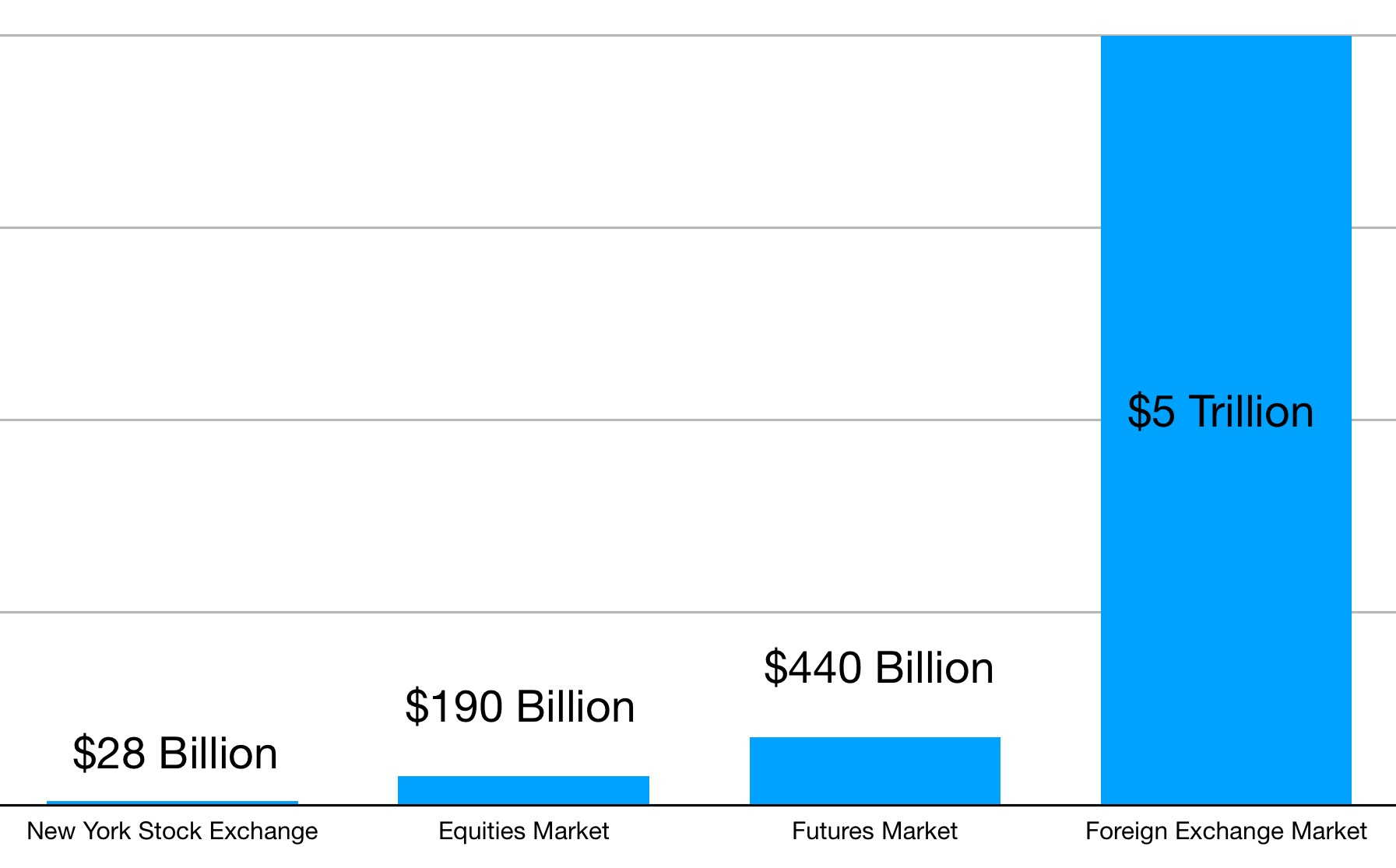
Forex Basics Tutorial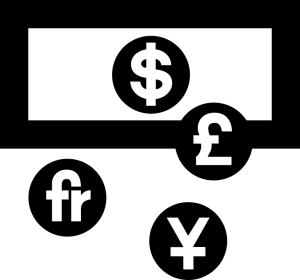
As I just mentioned, the currency market has open around the clock and only closes on the weekends. It is relevant for the entire world as all world’s currencies trade there. The most dominant currency remains the US Dollar (USD) and that is followed by the Euro (EUR). More on that in a second.
It is important to understand that a currency’s value is very relative. A currency’s value on its own does not fluctuate. It always remains 1:1. Therefore, you always need a second currency to compare the first one to. This is also what happens in Forex. You can’t really trade a currency on its own. They only come in pairs. The most traded pair is the following:
EUR/USD
Let’s say this currency pair is trading at 2, so EUR/USD = 2. This would mean that 1 EUR is worth 2 USD, so for 1€ you can get 2$ (€1 = 2$). The first currency in a currency pair is always called the base currency. The second one is called the quote currency. In other words, the first currency is quoted in the second one. In our EUR/USD example, it would mean that the value of 1 EUR is quoted in USD.
If you go long or buy a currency pair, you will always buy the base (first) currency and sell the quote (second) one. If you sell or go short a pair, it is the other way around (sell base, buy quote).
Major Currency Pairs (Majors)
There are hundreds if not even more currency pairs available. But not all of them are traded nearly as much as others. The main ones all have the USD in it, have very high liquidity and thus very tight spreads. They are also referred to as majors:
| EUR/USD | Euro Zone/United States |
| USD/JPY | United States/Japan |
| GBP/USD | United Kingdom/United States |
| USD/CAD | United States/Canada |
| USD/CHF | United States/Switzerland |
| AUD/USD | Austrailia/United States |
| NZD/USD | New Zealand/United States |
Cross Currency Pairs (Crosses)
The majors may be the most liquid and most traded currencies, but they are far from all. Besides the majors there are plenty more currencies. The next currency category in terms of liquidity are the crosses or cross-currencies. These are usually still big and well-known currencies, but without the USD. These don’t exist as long as the majors. Before these were made up, you always had to convert the currencies into USD and afterwards in the desired currency. The crosses allow you to skip this and offer direct exchanges:
| EUR/GBP | Euro Zone/United Kingdom |
| EUR/CHF | Euro Zone/Switzerland |
| EUR/CAD | Euro Zone/Canada |
| EUR/AUD | Euro Zone/Australia |
| EUR/NZD | Euro Zone/New Zealand |
| EUR/JPY | Euro Zone/Japan |
| GBP/JPY | United Kingdom/Japan |
| CHF/JPY | Switzerland/Japan |
| CAD/JPY | Canada/Japan |
| AUD/JPY | Australia/Japan |
| NZD/JPY | New Zealand/Japan |
| GBP/CHF | United Kingdom/Switzerland |
| GBP/AUD | United Kingdom/Australia |
| GBP/CAD | United Kingdom/Canada |
Exotic Currency Pairs (Exotics)
Even now, there are more currencies in the world. Therefore, exotic currency pairs exist. These are pairs made up from one bigger, major currency pair and one less well-known currency from a smaller economy. As imaginable, these aren’t as liquid as the majors or the crosses. Some exotics have quite limited liquidity and thus wide spreads, making entry and exit cost higher. Here are a few examples of exotic currency pairs:
| USD/SGD | United States/Singapore |
| USD/HKD | United States/Hong Kong |
| USD/NOK | United States/Norway |
| USD/DKK | United States/Denmark |
| USD/SEK | United States/Sweden |
| EUR/ZAR | Euro Zone/South Africa |
| EUR/TRY | Euro Zone/Turkey |
On a side note, most of these currencies have weird and funny nick names that you may notice some financial broadcasters or sites use. Here is a list of the nick names of some majors:
- USD: Buck
- EUR: Fiber
- GBP: Cable
- CHF: Swissy
- CAD: Loonie
- AUD: Aussie
- NZD: Kiwi
Measures – Forex Pips Explained
Currencies are usually much less volatile than for example stocks. They practically never move full points like stocks. One reason for that is because most major currency pairs just don’t trade in as high ranges as stocks do. For example the EUR/USD, GPB/USD, USD/CHF and many more all trade around 1. This is very different with stocks. A typical blue cap stock often trades around 100$ or more. For a 100$ stock to increase or decrease a few points in value, isn’t that impressive. But if 1$ asset increases by a few points, it would be a multiple 100% incline.
Some currency pairs do trade in higher ranges though.
What Is A Pip In Forex Trading
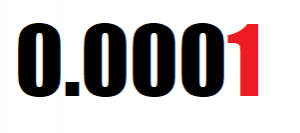
Most currencies practically never move points at a time. Therefore, there is something called a Pip. One pip is typically the 4th decimal number of a price. So if EUR/USD would be trading at 1,1001 and would increase to 1,1005, EUR/USD would have gained 4 Pips. Originally, Pips where the last decimal number displayed and the least that a price could move. But nowadays some brokers even display fractions of a Pip.
There are some exceptions like currency pairs with JPY (Japanese Yen). One Pip in pairs involving JPY is the second decimal number. (0.01).
What Is The Value Of A Pip
To calculate the value of one single Pip, you have to divide it through the exchange rate:
- 1 Pip / Exchange Rate = Value
- Example: USD/CHF = 1.0987 → 0.0001 / 1.0987 = 0.0000910167 $
- Example: USD/JPY = 110.55 → 0.01 / 110.55 = 0.000090498 $
- Example: EUR/USD = 1.1885 → 0.0001 / 1.1885 = 0.00008414 € => 0.00008414 x 1.1885 = 0.0001 $
What Is A Lot – Standard Lot Size Forex
In finance a lot symbolizes the standardized quantity for an instrument. This is the same with options, Forex and more. In options a standard lot is 100 shares, so 1 option contract controls 100 shares of the underlying. In Forex one standard lot is 100 000 units of a currency. This is because as we just covered, currencies only move very little and to profit from that you needed to buy many units. In the past, this was necessary and therefore the standardized unit amount was 100 000 units. There are different lots as you can see in the table below:
| 1 Lot | Number of Currency Units |
|---|---|
| Standard | 100,000 |
| Mini | 10,000 |
| Micro | 1,000 |
| Nano | 100 |
With this big sizes, already a move of one Pip can lead to some profit or loss. To calculate this you have to multiply the number of currency units times the value of one Pip (which we calculated before). Here are the profits or losses from a 1 Pip move with a position size of 1 standard lot:
- USD/CHF: 0.0000910167 $ x 100 000 = 9.10167 $
- USD/JPY: 0.000090498 $ x 100 000 = 9.0498 $
- EUR/USD: 0.0001 $ x 100 000 = 10 $
What Is Leverage In Forex

Luckily for us, we don’t have to buy huge numbers of units to create any profit in Forex. This is mainly thanks to leverage. Leverage allows you to control more units with less capital. It’s easiest to understand this with an example. Let’s say we have 1:100 leverage in this example. 1:100 leverage would mean that every 1$ invested would control 100$. So instead of investing 100 000$ to buy currencies, you’d only have to pay 1000$ and could control the same amount. The 1000$ payment is considered the margin which you have to pay up front. The other 99 000$ would theoretically be borrowed from your broker. This means your gains with leverage are much higher than without. So you can easily control a position size of one lot without having to invest huge amounts of capital. But be careful because the same goes for the downside. Your losses will also be much larger with leverage. Never trade with too much leverage. Different brokers offer different amounts of leverage. But I would never recommend to use more leverage than 1:200.
Driving Factors – What affects Forex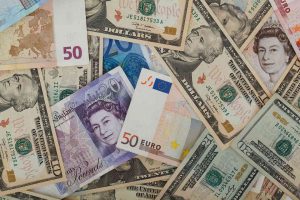
Currencies have many relevant driving factors that can influence currency prices. Currency pairs consist of two currencies from two different countries (or regions) (for example AUD/USD Australian Dollar/United States Dollar). The comparison of the currencies can also be thought of as a comparison of the two economies. Each currency represents the economy of its country (or region). So if for example AUD/USD is rising sharply, it probably is because the Australian economy is currently improving more or decreasing less than the US economy.
Therefore, driving factors for economies automatically also are driving factors for Forex. Financial crisis, elections, referendums, FED announcements, interest rate changes, (natural) disasters, Quantitative easing/tightening (QE), GDP announcements, unemployment reports and much more influence Forex a lot. In general, news and announcements have a much larger effect on currencies than on stocks. Especially events regarding inflation and interest rates play a huge role in the world of Forex. But not only the events and changes themselves affect the currency prices. Fx prices often make big moves just based on theoretical statements, said in speeches from people in respected positions.
Specific prices often moved many pips, just because someone took the words ‘interest rates’ in their mouth in a speech.
Expectation vs Actual:
When looking at these events, they usually regard one or multiple numbers: for example the GDB, employment/unemployment rates, interest rates, debt and more. All of these announcements basically focus on one specific number. Before these numbers are released, the markets have specific predictions/expectations. These are very important for later price movements. A rule of thumb is:
If the expectation is worse than the actual news, prices will rise and vice versa.
Prediction/Forecast < Actual = Positive Effect On Currency
This means if a number that should be high is higher than expected, prices will most likely rise. For example, if the US GDP per capita is expected to be $50’000, but turns out to be $55’000 this year, the US Dollar will probably rise compared to another country’s currency (unless that country has even better news). But if the GDP per capita turns out to be less than expected, let’s say $45’000, the USD should depreciate in value compared to another currency that isn’t experiencing any other major problems. This all might seem pretty obvious, but it is very important. It is essential to know the expectation if you plan on trading throughout these events. Even if a number improves compared to previous years, but still is worse than the expectations, prices will likely fall. Also note that a higher number is not always better. As an example, higher unemployment numbers aren’t good. In this case prices should rise, if the expectation is higher than the reality.
Commodities and Currencies
Additionally, some country’s economies are based on commodities like gold or oil. As an example Russia heavily rely on their oil exports whereas other countries rely on importing this oil. If enough oil importing countries decide to stop buying or trading oil with Russia, Russia’s economy and currency will suffer, leading to an increase in e.g. USD/RUB (if the US aren’t having even bigger troubles in their country). In general, Russia’s currency (Ruble) will be correlated to the oil price. If new oil fields are discovered, oil’s overall supply will be increased, thus leading to a decrease in oil price, meaning that the Ruble will depreciate in value.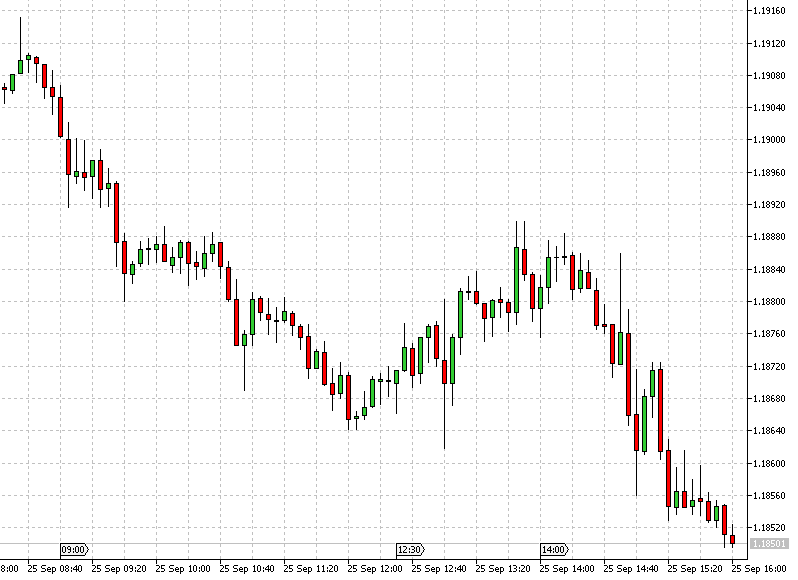
Another of many examples of a country that is dependent on a commodity, is Australia and Gold.
Technical Analysis and Forex
Furthermore, technicals are way more present and relevant in Forex. Very many Fx traders use some sort of technical analysis in their trading. The more people use technical analysis, the more reliable it usually becomes. Price levels, support and resistance lines and other significant price points should be considered when trading currencies. The reason for this importance is that if many traders identify these levels, more people will place stop losses or orders around these levels and as soon as one significant level is broken these orders should get filled leading to a bigger price reaction.
Differences To Other Markets: Stock Market
Even though the foreign exchange market essentially does work similar to other markets like the stock exchange, it still is quite different. An experienced and profitable stock trader won’t necessarily be a good and profitable Forex trader. Skills, techniques and strategies acquired in one market won’t always translate to the currency market. Of course, it does help but you still have to get used to the new conditions.
One big difference is that stocks tend to naturally appreciate in value. This is very different for currencies. If you had invested into the S&P 500 ten or more years ago, you would have been profitable, the same goes for many other stocks. Most good stock’s prices automatically rise over the course of long time frames. Therefore, a strategy like ‘Buy and Hold’ works so good with stocks. A strategy like this could never really work in the currency market. You can’t say that a currency has good fundamentals and will likely increase in value over the course of the next few years. It is practically impossible to make predictions like this one. There are so many unpredictable events that influence currency’s. You just can’t predict natural disasters, elections, referendums, FED announcements that take place in a few months or years time. So many factors like these play a huge role in Fx and therefore the prices fluctuate all the time. But most currency pairs still trade in similar ranges as they did 10 years ago.
In general, the Forex is laid out for much shorter term investing. It is probably easier to profit from small daily price swings in Forex than in stocks.
Moreover, news and events are of much greater significance in the world of Forex. Yes, major FED announcements and other events do affect some stocks. But the effects are in no way similar to the ones on Forex. Even minor remarks in less important speeches can make currency prices move.
A Forex Strategy
There are endless profitable and rather complex Forex strategies that you could learn. But there also are simple and beginner friendly strategies, one I want to present now. This strategy relies on events and a reaction to that event. Practically anyone can use this strategy. This strategy relies on an event taking place and a market reaction that you have to predict.
- EVENT → MARKET REACTION
- Example 1: Natural Disaster: Earthquake, killing 57 people and destroying hundreds of buildings in Mexico → EUR/MXN will rise (BUY) (Heavy economic damage in Mexico, no major problems in Euro Zone)
- Example 2: Announcements that Interest Rates will probably rise in the near future in the US → EUR/USD will fall (SELL) (If Interest Rates rise, a currency usually tends to appreciate in value)
- Example 3: Unemployment Data is lower than expected in Australia, whereas the US has a lower GDP than expected → AUD/USD will rise (BUY) (Lower unemployment is good and a lower GDP isn’t good)
This could be a way of making money in the foreign exchange market, but it may be more complex than you think. These examples make it seem quite easy. But usually every country and currency has some struggles and thus things aren’t that black and white. Nevertheless, watching the markets and seeing how they react during events like these can be enlightening and will generally give you a better understanding.

Safe Havens In The Forex Market
When the Forex market is volatile and times are uncertain, investors tend to avoid currency positions. In these times, traders often choose to allocate their money in safer assets that don’t get affected by crisis or other events. Gold is one of these ‘safe havens’. As their only is a limited amount of gold in the world, gold never really loses too much of its value. Therefore, in times of uncertainty gold prices often rise.
Conclusion
Finally, almost finished!
Summed up, Forex is a special kind of market that does vary from other markets like the stock exchange. This means just because you master one, you won’t necessarily master the other one too. Forex is not good for very long term investing and strategies like ‘buy and hold’. Forex is much better for short term trading.
There are countless things that affect the currencies and therefore it is very important to have a great market awareness to constantly have an idea of what is going on in the markets. To develop this, you should have something like a news feed and an economic calendar.
In general, Forex is no easy topic and just like other trading, it takes time and dedication to learn. This education is very important to trade currencies profitable. Forex trading can take up more time than other trading activities, because:
- Forex only closes on weekends and has open 24 hours on the weekdays
- You have to pay more attention to news and upcoming events
I recommend starting to get into Forex with paper trading on demo accounts. This is a great way of getting used to the markets and a broker. Thereby you can track different currencies and their reactions to specific events.
Before you start with actual money, you should definitely have a clear idea of what you are doing, know how to manage your risk and have a trading plan/strategy. Otherwise, you will very likely end up losing all your money. Especially because of the added risk due to the leverage. Never use too much leverage!
And never invest more than you can afford to lose!
Thanks so much for reading. I really do hope that you enjoyed it and learned a lot. As you may know (or not), this is my first of potentially more articles on Forex. If you enjoyed it and want to see more articles on Forex, please let me know in the comments below.
[qsm quiz=4]

Awesome article! This is a great read for beginners that might want to learn a little more about forex. My self an investor have never really entered the forex market yet but have definitely thought about it. So far I have just stuck to security’s on stock exchanges.
Whats your thought on binary options as they are kind of related to forex?
Cheers
Hey Mack,
Thanks for your comment! Binary options are a controversial topic. Not too long ago I published an article about binary options and my thoughts on them. You can read it here:
Is Trading Binary Options a Scam – My Honest Opinion
Hey, great article. never knew there could be so much to forex or currency trading. I didn’t realise there was so much that could affect the value, price, etc.
I think this is a great read for anyone interested in getting started, as there is a lot to learn with any kind of trading and this article did teach me a lot. i also like that there are demo accounts to help you learn.
Thanks
John
Hey man,
Great to hear that you learned new things and enjoyed the article. If you ever need help with anything, please let me know in the comments.